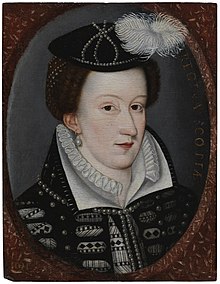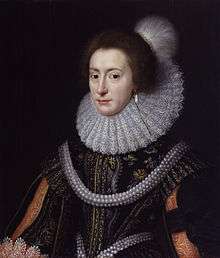Nicolas Elphinstone
Nicolas Elphinstone (floruit 1560-1580) was a Scottish courtier and diplomatic messenger.
He was a member of the Elphinstone of Schank family. Schank was in Arniston in Midlothian.
Master Nicolas or Nicoll Elphinstone worked for James Stewart, Regent Moray and was involved in attempts to sell the jewels and pearls of Mary, Queen of Scots in 1567 and 1568.[1] Moray needed to raise money to govern Scotland and subdue Mary's supporters by force.[2] It was also said that he went to England in July 1565 to raise £10,000 for Mary's political opponents, at the time of her marriage to Lord Darnley, finance for the rebellion known as the Chaseabout Raid.[3]

Elphinstone in London
Mary Queen of Scots was imprisoned in Lochleven Castle by the Confederate Lords after the battle of Carberry Hill. Her half-brother, James Stewart, Earl of Moray, was in London. He sent Nicholas Elphinstone to her in July 1567, but the Lords would not allow him to see the queen. The Confederate Lords considered sending Elphinstone to France to declare their actions to Charles IX.[4] James Stewart arrived in Scotland and was made Regent of Scotland on 22 August 1567. He now had control of royal property including a chest of jewels in Edinburgh Castle.[5]
On 20 October 1567 Moray sent Elphinstone to Berwick-upon-Tweed and London with a consignment of the queen’s jewels. These pieces were intended for sale and not to be pledged for loans. They were given an estimated value of 9,000 French crowns. The consignment included:[6]
- A chain of 91 little rings with two sparks of rubies (except two missing), with 12 square "intermiddis" (entredeux) set with table diamonds, and one round entredeux with a ruby, and two rock rubies. Estimate 3,000 French crowns.
- Four great table rubies in a gold garnishing (head-dress). Estimate 3,000 French crowns.
- Four great table diamonds set in the same fashion. Estimate 3,000 French crowns.

Elphinstone sold a large group of pearls to Elizabeth at the end of April 1568. These pearls have come to be known as the "Medici pearls". Pope Clement VII is said to given them to Catherine de' Medici as a wedding gift. Brantôme wrote that she gave them to Mary and he saw her wearing them.[7] Catherine made efforts to buy them back in London.[8] The pearls were given in 1613 to Princess Elizabeth at her marriage, and some are thought to have returned to the British royal family.
The attempted sales in London are known from the letters of a French diplomat, Bochetel de Forrest. Bochetel described the great pearls in detail. There were six cordons sashes strung like paternosters, each with twenty five pearls, many large and beautiful, the most part as big as muscady nuts, nutmegs. They were valued by several merchants for Elizabeth. English merchants offered 10,000 crowns, Italians 12,000, a merchant from Geneva suggested 16,000. Elizabeth, it was thought, paid 12,000. The rest of the jewels on offer were not so valuable, except a well mounted piece of unicorn horn.[9]
Bochetel de Forrest described how Elpinstone had met the Scottish double-agent Ninian Cockburn, alias "Beaumont", on his journey at Berwick. Nicholas Throckmorton arranged his audience with Elizabeth, and Elphinstone showed her the jewels and pearls in the presence of the Earls of Pembroke and Leicester.[10] Bochetel wrote that the jewels were carried secretly to London and the pearls sold to Elizabeth for twelve thousand crowns: "ces bagues ... ont este icy envoyees fort secretement, et en fin, comme jay cy devant escript, acheptees par ceste royne pour le somme de douze mil escus."[11] The concluded sale was not kept secret: when Elphinstone came to Carlisle in June 1568, Mary asked for his arrest as "hyr grevous enemye and seller of hyr juells".[12] William Kirkcaldy of Grange noted the sale in his memorandum on the Edinburgh Castle jewel coffer: "Item Mr Nycoll Elphingston sauld the pearll in London for xiij m or xiiij m quhilk the Queen of England hes for hir self & causit by them."[13]
The jewel sales were halted by Mary’s escape from Lochleven and arrival in England on 16 May 1568. Elizabeth now had to appear impartial to causes in Scotland. She bought no more jewels directly from Moray’s agents and made efforts to prevent other sales of Mary’s goods in England.[14] Elphinstone sent a letter to William Cecil when he got back to Edinburgh on 21 May 1568, carried by a man who had been at the battle of Langside and would describe the battle to Cecil.[15]
Elphinstone continued to take messages to Elizabeth and Cecil for Regent Moray. Moray gave him a length of black velvet for his clothes and 120 French gold crowns to go London in January 1570.[16] His instructions were to discuss offers to William Drury, the Marshal of Berwick, for him to lead an army in Scotland against Mary's supporters, issues following the Rising of the North, and Moray's actions against his rebels. Elphinstone was to press for at least £1,000 and £1,000 yearly to protect Protestant Scotland.[17] Later there was some uncertainty about any commitment to pay this money. Elizabeth sent Thomas Randolph to Scotland in reply, but Moray had been assassinated.[18]
Elphinstone was still in London when news of the assassination broke. He assumed the story was untrue, a rumour spread by Mary's secretary the Bishop of Ross, and wrote to Cecil with this theory. Unsold jewels were left with Regent Moray's widow, Agnes Keith.[19]
Elphinstone had £50 yearly from the English exchequer as a pension for supporters of English policy in Scotland. He was described as a good servant to the late Regent Moray, wise and well affected (to England), and in great favour with Regent Morton.[20]
During the crisis following the border incident known as the Raid of the Redeswire, Regent Morton considered sending Elphinstone as an envoy to Queen Elizabeth, until her ambassador Henry Killigrew arrived in Edinburgh.[21]
He brought a copy of the illustrated costume book, Richard Breton and François Desprez, Recueil de la diversité des habits (Paris, 1562), and Les songes drolatiques de Pantagruel (Paris 1565), for the young king's library.[22]
References
- Karen Raber, 'Chains of Pearls: Gender, Property, Identity', in Bella Mirabella ed, Ornamentalism: The Art of Renaissance Accessories (University of Michigan, 2011), pp. 159-180.
- Calendar State Papers Foreign: Elizabeth, vol. 8, nos. 1658, 1676, 1724: HMC 6th Report: Earl of Moray (London, 1877), p. 643: National Records of Scotland E35/10.
- David Laing, History of the Reformation by John Knox, vol. 2 (Edinburgh, 1848), p. 496.
- Joseph Bain, Calendar State Papers Scotland, vol. 2 (Edinburgh, 1900), pp. 354, 356, 371.
- Joseph Bain, Calendar State Papers Scotland, vol. 2 (Edinburgh, 1900), p. 386.
- Historical Manuscripts Commission 6th Report: Earl of Moray (London, 1877), p. 643.
- P. Brantôme, Mémoires de Messire Pierre du Bourdeille, seigneur de Brantôme, contenans les vies des dames illustres de France de son temps (Paris 1665), p. 39 Brantôme does not say the pearls were a gift to Catherine from the Pope.
- Joseph Robertson, Inventaires de la Royne Descosse (Edinburgh, 1863), pp. 10-11: Teulet, Relations, vol. 2, pp. 352, 367-8: G. Bapst, Histoire des joyaux de la couronne de France (Paris, 1889), pp. 22-3: Labanoff, Lettres de Marie Stuart, vol. 7, pp. 129-30, 132-3: The letters published by Teulet are BNF Français 15971, f.91, 93, 105, 109, 112.
- Labanoff, Lettres de Marie Stuart, vol. 7, pp. 132-3. Bochetel's French words for nutmeg "noix muscades" seem to be the origin of an idea that Mary's pearls were black, by confusion with the word "noir".
- Alexandre Labanoff, Lettres de Marie Stuart, vol. 7 (London, 1852), pp. 129-130, the place-name is printed "Varvich".
- Bibliothèque nationale de France BNF Français 15971, f.109
- Calendar State Papers Scotland, vol. 2, p. 422.
- National Records of Scotland E35/9/3, Grange’s memorandum of jewels in Edinburgh Castle.
- Calendar State Papers Foreign: Elizabeth, vol. 8, nos 2577, 2585.
- Calendar State Papers Scotland, vol. 2, p. 411.
- Charles Thorpe McInnes, Accounts of the Treasurer of Scotland (Edinburgh, 1970), pp. 184-5.
- William Boyd, Calendar State Papers Scotland, vol. 3 (Edinburgh, 1903), pp. 53-5.
- William Boyd, Calendar State Papers Scotland, vol. 3 (Edinburgh, 1903), pp. 58-61.
- William Boyd, Calendar State Papers Scotland, vol. 3 (Edinburgh, 1903), pp. 63-4.
- William Boyd, Calendar of State Papers Scotland: 1574-1581, vol. 5 (Edinburgh, 1907), pp. 1-2.
- William Boyd, Calendar of State Papers Scotland: 1574-1581 (Edinburgh, 1907), p. 172.
- G. F. Warner, Library of James VI (Edinburgh, 1893), p. lxiii.